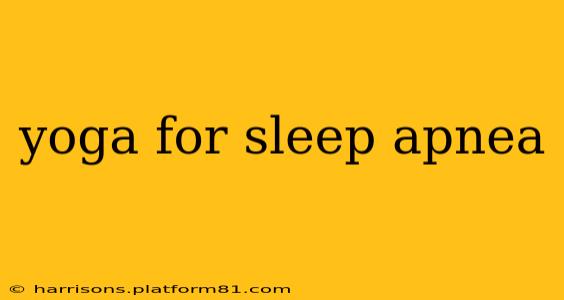Sleep apnea, a condition characterized by pauses in breathing during sleep, affects millions and significantly impacts sleep quality and overall health. While medical treatments are crucial for managing severe cases, incorporating yoga into your routine can be a valuable complementary approach to improve sleep and potentially mitigate some symptoms. This article explores how yoga can help manage sleep apnea, addressing common questions and concerns.
What are the Benefits of Yoga for Sleep Apnea?
Yoga offers a multifaceted approach to improving sleep apnea symptoms. The practice combines physical postures (asanas), breathing exercises (pranayama), and meditation, all of which can positively impact sleep and respiratory function. Specifically, yoga can:
- Improve respiratory function: Certain yoga poses and breathing exercises strengthen the diaphragm and respiratory muscles, promoting better airflow and reducing the likelihood of breathing pauses during sleep.
- Reduce stress and anxiety: Stress is a known contributor to sleep apnea. Yoga's relaxation techniques help calm the nervous system, reducing stress hormones that can interfere with sleep.
- Promote better sleep hygiene: Establishing a regular yoga practice can contribute to a more consistent sleep schedule, a key aspect of good sleep hygiene.
- Increase body awareness: Yoga encourages mindfulness and body awareness, which can help you identify and address potential contributing factors to your sleep apnea, such as poor posture or tension.
Can Yoga Cure Sleep Apnea?
No, yoga cannot cure sleep apnea. It's crucial to understand that yoga is a complementary therapy, not a replacement for medical treatment. If you have been diagnosed with sleep apnea, you should continue to follow your doctor's recommendations, including using a CPAP machine if prescribed. Yoga can, however, significantly improve your sleep quality and potentially reduce the severity of your symptoms, making it a valuable addition to your treatment plan.
What Types of Yoga Are Best for Sleep Apnea?
While many yoga styles can be beneficial, certain types are particularly well-suited for addressing sleep apnea symptoms:
- Restorative Yoga: This gentle style focuses on deep relaxation and stress reduction, making it ideal for improving sleep quality. The passive nature of the poses allows for complete relaxation of the body and mind.
- Hatha Yoga: Hatha yoga provides a balanced approach, incorporating both gentle stretching and strengthening poses that can improve respiratory function and flexibility.
- Pranayama (Breathing Exercises): Specific breathing techniques, such as diaphragmatic breathing and Ujjayi breath (ocean breath), can strengthen the diaphragm and improve lung capacity, directly impacting respiratory function. Practicing these regularly can significantly impact sleep quality.
What Yoga Poses Are Helpful for Sleep Apnea?
Several yoga poses can be particularly helpful for improving respiratory function and reducing sleep apnea symptoms. These include:
- Bhujangasana (Cobra Pose): Gently stretches the chest and lungs, improving breathing capacity.
- Uttanasana (Standing Forward Bend): Calming and helps to reduce stress and anxiety.
- Viparita Karani (Legs-Up-the-Wall Pose): Promotes relaxation and improves circulation.
- Supta Matsyendrasana (Reclining Spinal Twist): Gently massages the abdominal organs, aiding digestion and promoting relaxation.
- Savasana (Corpse Pose): This final relaxation pose is crucial for integrating the benefits of the practice and promoting deep rest.
How Often Should I Practice Yoga for Sleep Apnea?
The frequency of yoga practice depends on individual needs and preferences. A consistent practice, even just a few times a week, can yield significant benefits. Starting with shorter sessions (15-20 minutes) and gradually increasing duration is recommended. Listening to your body and respecting its limitations is key.
Are There Any Risks Associated with Yoga for Sleep Apnea?
While generally safe, yoga should be practiced mindfully, particularly if you have existing health conditions. Individuals with severe sleep apnea should consult their doctor before starting a yoga practice, especially if they are also on medication or using a CPAP machine. Always listen to your body and avoid pushing yourself too hard.
Conclusion
Yoga offers a natural and holistic approach to supporting sleep apnea management. By combining physical postures, breathing exercises, and relaxation techniques, yoga can improve respiratory function, reduce stress, and promote better sleep hygiene. However, it's essential to remember that yoga is a complementary therapy, not a cure. Always consult with your doctor or healthcare provider to determine the best course of treatment for your sleep apnea. Integrating yoga into your lifestyle can be a valuable step towards improving your sleep quality and overall well-being.
